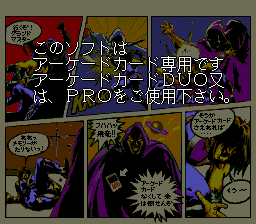Review | Screenshots | Dialogue | Concept Art | Merchandise | End Credits
Strider
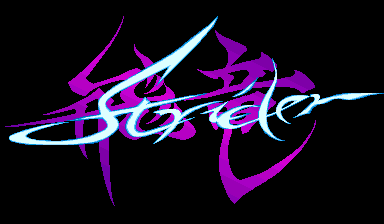
This is the game that started it all: a frenetic 24-color five-level masterpiece of an action platformer exuding coolness from every weapon swipe, every rolling slide tackle, and every cartwheeling leap into the unknown. Strider is action gaming at its finest. It is a master class of videogaming craftsmanship; its levels' layouts follow every path but a straight line, belying the simple fact that this is a platformer, of all things; its character designs are vibrant and detailed, like they stepped out of a classic anime; and its music manages to walk a fine line, providing an emotional connection to the events onscreen while also delivering much-needed adrenaline.
Isuke, Junko Tamiya, and the others who worked on Strider set the bar so high that no one could top it, not even Capcom themselves. Strider 2 came close (oh, so tantalizingly close!) but ultimately failed to completely recapture its predecessor's freewheeling spirit. For in the end, what made Strider successful was how well all of its parts meshed together. Isuke has said that he wanted to see how far he could take an action game with one lever and two buttons. He set out to improve on Ghosts N' Goblins' level design, "imagining a magnificent playing field. Running up steep slants, climbing vertical walls, running back down, jumping over things, hanging off ledges, and running, running, running to freedom." His plans succeeded. Strider's smooth acrobatics, glitch-free programming, memorable score, and flowing levels unfolded with such grace and style that anything of lesser quality could only seem rushed by comparison.
The only negative thing that could be said about this game is that its plot is somewhat contrived. The well-worn trope of the power-mad despot trying to rule the world and the solitary hero who rises up to stop him has been done before; but rarely had it been done so well. Unlike many games before and after, Strider's story is not exclusively told through cutscenes. Instead, its cutscenes support the story told through the gameplay itself.
It's no wonder the game was popular. It ended up being ported to every conceivable home system, the first of which was the Amiga.
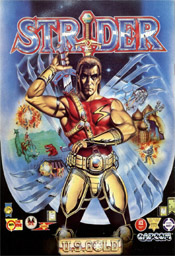 The Amiga port often gets a bad rap for not being true to the arcade. Given what the programmers had to work with, this conversion didn't do a bad job. Granted, the floating menu takes up a huge chunk of screen real estate that could have been used for the in-game graphics, but that's no huge loss. And granted, a variation of that godawful box art ended up being used for every U.S. Gold/Tiertex port.
The Amiga port often gets a bad rap for not being true to the arcade. Given what the programmers had to work with, this conversion didn't do a bad job. Granted, the floating menu takes up a huge chunk of screen real estate that could have been used for the in-game graphics, but that's no huge loss. And granted, a variation of that godawful box art ended up being used for every U.S. Gold/Tiertex port.
What's a more significant loss is that, along with leaving out tons of animated frames, the programmers of this port apparently left out the ending, too. Once the game is completed, the game simply deposits the player back at the beginning of the first level, a la Ghouls N' Ghosts. Subsequent play-throughs only lead to more game resets.
The biggest issue with this port is the fact that it was licensed out to U.S. Gold/Tiertex. They developed it because Capcom preferred to focus on the ports for the more powerful and established systems. Unfortunately, US Gold/Tiertex's involvement in the conversion left them in a position to capitalize on the Strider trademark independently from Capcom, which would later lead to the embarrassment known as Strider Returns.
All things considered, though... U.S. Gold/Tiertex's Amiga port was the best of their efforts, by far. Their others fared far worse. A port to the Amstrad CPC just happens to be the worst Strider conversion of all time. At any given time, that port only showed about a quarter of what the CPS-1 did onscreen. Sometimes bullets fired offscreen resulted in a cheap death. Limited frames of animation made gameplay difficult. Ouroboros' transformation, Hiryu's cartwheel jump, and Lago's fire-snakes are barely animated, if at all. Parts of the levels have been redesigned, making isolated screenshots difficult to identify. The Commodore 64 and DOS ports followed the Amstrad CPC's lead, though they did manage to improve on its graphics somewhat. These systems couldn't handle the high resolutions of an arcade machine, so it really isn't fair to gripe too much.
 While U.S. Gold and Tiertex were working on their outsourced hack jobs, Capcom was conspiring with Sega and NEC. Capcom was in a bit of a pickle: they had a license to produce games for the NES. Nintendo did not like their third-party developers working with the competition. Sega's MegaDrive/Genesis hardware was very similar to Capcom's CPS-1 board, though. The possibility of a nearly arcade-perfect port was too good to pass up, but the threat of a lawsuit from Nintendo made them cautious. Instead of porting it in-house, Capcom lent the staff who'd worked on Strider to Sega, and let Sega do it themselves. For added plausible deniability, Sega slapped a "reprogrammed game" copyright on the title screen.
While U.S. Gold and Tiertex were working on their outsourced hack jobs, Capcom was conspiring with Sega and NEC. Capcom was in a bit of a pickle: they had a license to produce games for the NES. Nintendo did not like their third-party developers working with the competition. Sega's MegaDrive/Genesis hardware was very similar to Capcom's CPS-1 board, though. The possibility of a nearly arcade-perfect port was too good to pass up, but the threat of a lawsuit from Nintendo made them cautious. Instead of porting it in-house, Capcom lent the staff who'd worked on Strider to Sega, and let Sega do it themselves. For added plausible deniability, Sega slapped a "reprogrammed game" copyright on the title screen.
The quasi-legality of what they did may have been questionable, but oh, what a result. Strider for the Genesis was a brilliantly done port. It underwent a minimum of surgery to shave it down to the size necessary to fit on a Genesis cartridge: Hiryu's cypher slash lost its animation and everything became slightly more pixelated overall. There had initially been some debate whether the Amazon stage was going to make the cut, but ultimately Sega fit the whole game, intact, onto the cartridge... even going so far as to add an entirely new ending (one that makes more sense). It went on to win award after award after award, becoming EGM's Game of the Year in 1990.
This version put the Genesis console on the map. Once it came out, everyone wanted a Genesis or MegaDrive. Most people who remember Strider remember it because of this port.
 Sega tried to reproduce their success on the Genesis with a Master System port that largely left fans cold. Those looking for a Strider fix wouldn't find it here. It's not like the Master System wasn't capable of more than this, because Rastan Saga proved. otherwise The graphics aren't the worst part of this port, however. The worst part is how the palette the programmers chose cannibalizes fan-favorite scenes. Hiryu's gi is supposed to be blue, not fuschia. His belt is silver, not green. Snow is white, not purplish. And so on, and so forth.
Sega tried to reproduce their success on the Genesis with a Master System port that largely left fans cold. Those looking for a Strider fix wouldn't find it here. It's not like the Master System wasn't capable of more than this, because Rastan Saga proved. otherwise The graphics aren't the worst part of this port, however. The worst part is how the palette the programmers chose cannibalizes fan-favorite scenes. Hiryu's gi is supposed to be blue, not fuschia. His belt is silver, not green. Snow is white, not purplish. And so on, and so forth.
Another not-so-minor annoyance was the near or total lack of gravity at some points in the game. Flying cartwheel jumps over pits sometimes didn't land, and invisible midair platforms caught players unaware. Glitchy programming and poor choices all around led to a general apathy towards this port, which translated into lackluster sales, compared to the Genesis'.
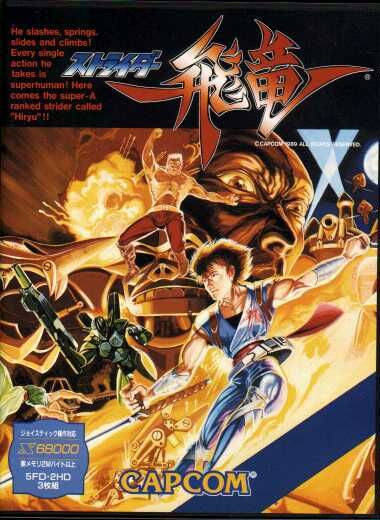 Perhaps unsatisfied with the latter port, Capcom went on to port Strider to Sharp's X68000, an incredibly popular Japanese home computer with no American counterpart. It had virtually identical hardware to Capcom's CPS-1 board, making it even more compatible with Capcom's games than Sega's MegaDrive. It was a natural choice for ports of Capcom's arcade games. In fact, "port" is hardly the right word for the X68000's Capcom conversions, since they were 99.9% identical to their arcade counterparts. The only real difference between the CPS-1 Strider and the X68000 version is the fact that the console version came on three old-style 5¼ floppy disks.
Perhaps unsatisfied with the latter port, Capcom went on to port Strider to Sharp's X68000, an incredibly popular Japanese home computer with no American counterpart. It had virtually identical hardware to Capcom's CPS-1 board, making it even more compatible with Capcom's games than Sega's MegaDrive. It was a natural choice for ports of Capcom's arcade games. In fact, "port" is hardly the right word for the X68000's Capcom conversions, since they were 99.9% identical to their arcade counterparts. The only real difference between the CPS-1 Strider and the X68000 version is the fact that the console version came on three old-style 5¼ floppy disks.
Seeing what Strider did for Sega's popularity made NEC salivate. Nintendo was not loved at the time, and NEC was involved in a huge console war with them. NEC worked with Capcom to produce a port for their SuperGrafx system, but that never came out for reasons so arcane as to be completely occult. Presently the SuperGrafx died on the vine and NEC Avenue cobbled together a Turbo Duo version to satisfy the hordes of PC Engine fans who wanted a Strider port for their system. They assembled some in-game cutscenes to expand on the game's story, remixed the soundtrack, and included a bonus desert level between Kazakh and Siberia (though they may have originally intended to include two bonus levels). And in this reviewer's humble opinion, they did a very decent job all around.
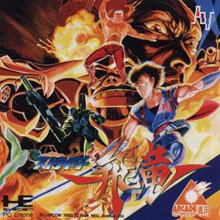 Strider suffered only slightly from being on the Turbo Duo instead of the SGX. The colors aren't quite as diverse as they would be on the other system, but that's about it. In all other respects, Capcom has improved upon the arcade version. The animation is fluid, the cutscenes add to the plotline rather than opening up new holes, and that CD-quality orchestral soundtrack is something to be lusted after. Its influence on the series can be seen in the way Strider 2 cribbed its ideas for wireframe mission guides from this conversion. There's a LOT of similarity between the way the PCE/TG-16 Strider and Strider 2 handle their cutscenes. The scenes are mostly still shots, for starters, although there are some animated shots. Some shots, like the one of Hiryu gliding into Kazakh, are animated using layers and scaling. Others, like the one of Hiryu's hijacked airship maneuvering over Ballog's landing strip, are animated the traditional way.
Strider suffered only slightly from being on the Turbo Duo instead of the SGX. The colors aren't quite as diverse as they would be on the other system, but that's about it. In all other respects, Capcom has improved upon the arcade version. The animation is fluid, the cutscenes add to the plotline rather than opening up new holes, and that CD-quality orchestral soundtrack is something to be lusted after. Its influence on the series can be seen in the way Strider 2 cribbed its ideas for wireframe mission guides from this conversion. There's a LOT of similarity between the way the PCE/TG-16 Strider and Strider 2 handle their cutscenes. The scenes are mostly still shots, for starters, although there are some animated shots. Some shots, like the one of Hiryu gliding into Kazakh, are animated using layers and scaling. Others, like the one of Hiryu's hijacked airship maneuvering over Ballog's landing strip, are animated the traditional way.
While I wouldn't consider the cutscenes canonical (they were NEC's invention, after all), their inclusion in the game really makes it stand out. The only problem with this game, aside from having to duck to kill the wolves in Siberia, is that you have to have the Arcade Card in order to play this game on the Duo. If you don't have the card, it displays an error message that's something like an in-game mini-comic. Here's what it says in English (translation courtesy of JSB-kun):
Hiryu: "Here we go! Grand Master..."
Hiryu: "Ah! There's not enough memory!"
Grand Master: "GWAHAHAHAHA!!! (sadistic laugh) Hiryu! Without an Arcade Card you can't go any further!"
Hiryu: "So, if only I had a Arcade Card I could.... GHUUUUUUU!!!"
Regardless of how each port changed it to fit the system, Strider remains a landmark in action platforming. Its place in videogaming history is assured and well-deserved, and its influence can be seen on games in every genre, from Shinobi to Guilty Gear. Slot it into the console of your preference and kick Meio's ass. Games like this don't come around very often.
Further Reading
Review | Screenshots | Dialogue | Concept Art | Merchandise | End Credits
